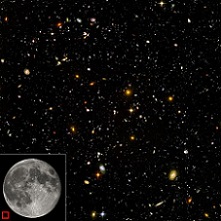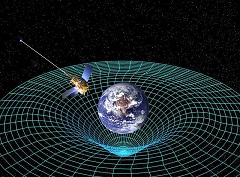 |
Size
- The Sun is 100 times larger than Earth in diameter and 1,300,000 times larger in volume. Solar flares are as big as many Earths.
- VY Canis Majoris is the largest known star in the universe. It has a diameter of 3 billion kilometers. It would take 1200 years to circle it in an airplane. It would take 8.7 hours to circle it at the speed of light.
- The Milky Way galaxy is 120,000 light years in diameter. There are countless other galaxies out there, containing countless stars.
- The “Hercules A” galaxy is 1.5 million light years across.
- Expansion of the universe (as measured by Hubble) increases with 70 km/second for every 3.26 million light-years you look further out into space. It is accelerating and will continue expanding forever.
- The Hubble eXtreme Deep Field (XDF) image covers an area less than a tenth of the width of the full Moon a tiny fraction of the sky, making it just a 30 millionth of the whole sky. Yet it reveals about 5500 galaxies, some of them so distant that we see them when the Universe was less than 5% of its current age.
- Andromeda, the nearest galaxy to ours is 2,538,000 light years away
- A galactic census project is currently underway. So far over 300,000 galaxies have been catalogued by volunteers analyzing images from the Sloan Digital Sky Survey.
- Scale of the Universe app provides a great perspective on the size of things
|
 |
Black Holes and Dark Energy
- Black holes are objects so dense, and with so much mass, that even light cannot escape their gravity. Super massive black holes, many millions of times the mass of our Sun, are at the center of all large galaxies, including our Milky Way galaxy. Hubble has found black holes 3 billion times as massive as our Sun at the center of some galaxies.
- Most galaxies in our cosmic neighborhood, including the Milky Way, appear to have a dormant black hole which is not funneling in large amounts of matter at present. The supermassive black hole at the center of our galaxy, weighing 4 million times as much as our sun, is dormant today but NASA astronomers theorize that two million years ago, it was 100 million times more powerful.
- Today astronomers believe that around three quarters of the mass of the Universe consists of dark matter, a substance quite different from the normal matter that makes up atoms and the familiar world around us. Dark Matter does not emit or reflect light. Normal matter, largely in the form of galaxies, accumulates along the densest concentrations of dark matter.
- More intriguing than dark matter is dark energy. Einstein's famous equation, E=mc2 tells us that energy and mass are interchangeable. Studies of the rate of expansion of the cosmos suggests that dark energy is by far the largest part of the Universe’s mass-energy content, far outweighing both normal matter and dark matter.
- Einstein predicted in his Theory of General Relativity that massive objects will deform the fabric of space itself, changing the path of light that passes through it.
|
 |
Age and Shape
- The age of the Universe, as determined by measurements from the Hubble telescope, is around 13.8 billion years, but due to the expansion of space humans are observing objects that were originally much closer but are now considerably farther away. The diameter of the observable universe is estimated at about 93 billion light-years, putting the edge of the observable universe at about 47 billion light-years away.
- WMAP spacecraft has determined that the universe is flat with only a 0.4% margin of error. This suggests that the universe is infinite in extent, however, since the Universe has a finite age, we can only observe a finite volume of the Universe. All we can truly conclude is that the Universe is much larger than the volume we can directly observe.
- A gravitational field has negative energy. Matter has positive energy. The two values cancel out provided the universe is completely flat. In this case the universe has zero energy and can theoretically last forever.
|
 |
Time Dilation and the Big Bang
- Time slows at higher speeds of the reference frame relative to another reference frame. Such slowing is called time dilation. This is evident by experiments such as slowing of atomic clocks aboard a Space Shuttle relative to synchronized Earth-bound inertial clocks. The duration of time can therefore vary according to events and reference frames. Einstein showed that the time and position at which one thought an event occurred, depended on how one was moving. This means that time and space, are inextricably bound with each other. The times that different observers assign to events would agree if the observers were not moving relative to each other. But they disagree more, the faster their relative speed.
- Objects with mass (energy) distort space-time and this distortion is what we perceived as the "force" of gravity. If you accelerate in the vacuum, you will feel the same type of force.
- In 2014 the BICEP2 telescope at the South Pole was used to observe images of gravitational waves, or ripples in space-time, which show that the universe burst into existence nearly instantaneously, throwing matter out into space faster than the speed of light.
|












